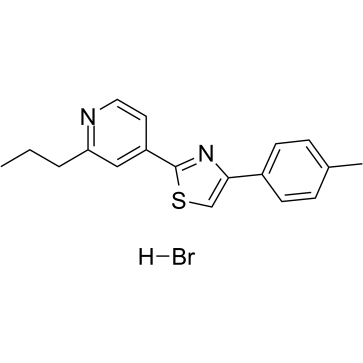| Description |
Fatostatin hydrobromide (125B11 hydrobromide), a specific inhibitor of SREBP activation, impairs the activation of SREBP-1 and SREBP-2. Fatostatin hydrobromide binds to SCAP (SREBP cleavage-activating protein), and inhibits the ER-Golgi translocation of SREBPs. Fatostatin hydrobromide decreases the transcription of lipogenic genes in cells. Fatostatin hydrobromide possesses antitumor properties, and lowers hyperglycemia in ob/ob mice[1][2].
|
| Related Catalog |
|
| In Vitro |
Fatostatin hydrobromide (125B11 hydrobromide) (0.1-1 μM; 3 days) inhibits the androgen-independent prostate cancer cell proliferation (IC50=0.1 μM) in an independent of the known IGF1-signaling pathway. Fatostatin hydrobromide inhibits insulin-induced adipogenesis of 3T3-L1 cells[1]. Cell Proliferation Assay[1] Cell Line: DU-145 cells Concentration: 0.1, 1 μM Incubation Time: 3 days Result: Impaired the IGF1-induced growth at an IC50 of 0.1 μM.
|
| In Vivo |
Fatostatin hydrobromide (125B11 hydrobromide) (30 mg/kg; 150 mL; i.p.; daily for 28 days) reduces adiposity, ameliorates fatty liver by reducing triglyceride (TG) storage, and lowers hyperglycemia in ob/ob mice[2]. Animal Model: Four-to-five-week-old homozygous male obese (ob/ob) mice (C57BL/6J)[2] Dosage: 30 mg/kg; 150 mL Administration: i.p. injection; daily for 28 days Result: Blocked increases in body weight, blood glucose, and hepatic fat accumulation in obese ob/ob mice, even under uncontrolled food intake.
|
| References |
[1]. Choi Y, et al. Identification of bioactive molecules by adipogenesis profiling of organic compounds. J Biol Chem. 2003 Feb 28;278(9):7320-4. [2]. Kamisuki S, et al. A small molecule that blocks fat synthesis by inhibiting the activation of SREBP. Chem Biol. 2009 Aug 28;16(8):882-92.
|

